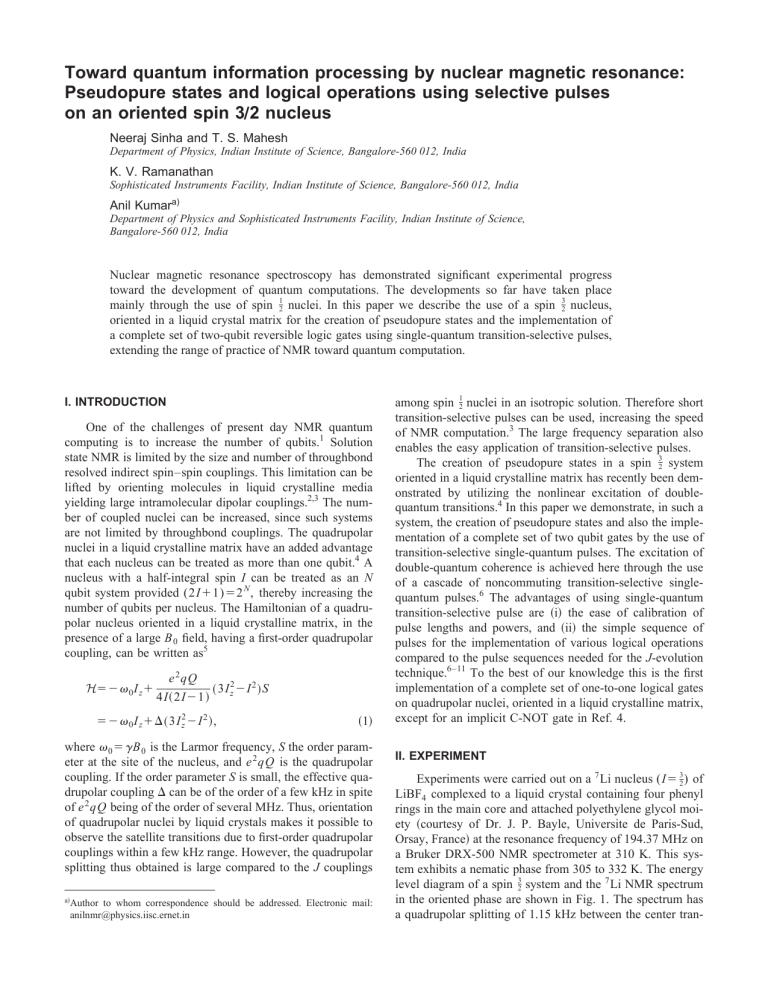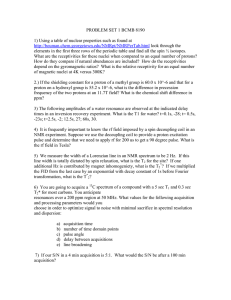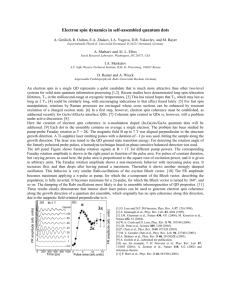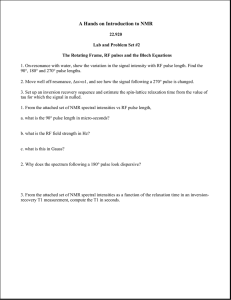Toward quantum information processing by nuclear magnetic resonance:
advertisement

Toward quantum information processing by nuclear magnetic resonance: Pseudopure states and logical operations using selective pulses on an oriented spin 3Õ2 nucleus Neeraj Sinha and T. S. Mahesh Department of Physics, Indian Institute of Science, Bangalore-560 012, India K. V. Ramanathan Sophisticated Instruments Facility, Indian Institute of Science, Bangalore-560 012, India Anil Kumara) Department of Physics and Sophisticated Instruments Facility, Indian Institute of Science, Bangalore-560 012, India Nuclear magnetic resonance spectroscopy has demonstrated significant experimental progress toward the development of quantum computations. The developments so far have taken place mainly through the use of spin 21 nuclei. In this paper we describe the use of a spin 23 nucleus, oriented in a liquid crystal matrix for the creation of pseudopure states and the implementation of a complete set of two-qubit reversible logic gates using single-quantum transition-selective pulses, extending the range of practice of NMR toward quantum computation. I. INTRODUCTION One of the challenges of present day NMR quantum computing is to increase the number of qubits.1 Solution state NMR is limited by the size and number of throughbond resolved indirect spin–spin couplings. This limitation can be lifted by orienting molecules in liquid crystalline media yielding large intramolecular dipolar couplings.2,3 The number of coupled nuclei can be increased, since such systems are not limited by throughbond couplings. The quadrupolar nuclei in a liquid crystalline matrix have an added advantage that each nucleus can be treated as more than one qubit.4 A nucleus with a half-integral spin I can be treated as an N qubit system provided (2I⫹1)⫽2 N , thereby increasing the number of qubits per nucleus. The Hamiltonian of a quadrupolar nucleus oriented in a liquid crystalline matrix, in the presence of a large B 0 field, having a first-order quadrupolar coupling, can be written as5 H⫽⫺ 0 I z ⫹ e 2 qQ 共 3I z2 ⫺I 2 兲 S 4I 共 2I⫺1 兲 ⫽⫺ 0 I z ⫹⌬ 共 3I z2 ⫺I 2 兲 , 共1兲 where 0 ⫽ ␥ B 0 is the Larmor frequency, S the order parameter at the site of the nucleus, and e 2 qQ is the quadrupolar coupling. If the order parameter S is small, the effective quadrupolar coupling ⌬ can be of the order of a few kHz in spite of e 2 qQ being of the order of several MHz. Thus, orientation of quadrupolar nuclei by liquid crystals makes it possible to observe the satellite transitions due to first-order quadrupolar couplings within a few kHz range. However, the quadrupolar splitting thus obtained is large compared to the J couplings a兲 Author to whom correspondence should be addressed. Electronic mail: anilnmr@physics.iisc.ernet.in among spin 21 nuclei in an isotropic solution. Therefore short transition-selective pulses can be used, increasing the speed of NMR computation.3 The large frequency separation also enables the easy application of transition-selective pulses. The creation of pseudopure states in a spin 23 system oriented in a liquid crystalline matrix has recently been demonstrated by utilizing the nonlinear excitation of doublequantum transitions.4 In this paper we demonstrate, in such a system, the creation of pseudopure states and also the implementation of a complete set of two qubit gates by the use of transition-selective single-quantum pulses. The excitation of double-quantum coherence is achieved here through the use of a cascade of noncommuting transition-selective singlequantum pulses.6 The advantages of using single-quantum transition-selective pulse are 共i兲 the ease of calibration of pulse lengths and powers, and 共ii兲 the simple sequence of pulses for the implementation of various logical operations compared to the pulse sequences needed for the J-evolution technique.6–11 To the best of our knowledge this is the first implementation of a complete set of one-to-one logical gates on quadrupolar nuclei, oriented in a liquid crystalline matrix, except for an implicit C-NOT gate in Ref. 4. II. EXPERIMENT Experiments were carried out on a 7 Li nucleus (I⫽ 23 ) of LiBF4 complexed to a liquid crystal containing four phenyl rings in the main core and attached polyethylene glycol moiety 共courtesy of Dr. J. P. Bayle, Universite de Paris-Sud, Orsay, France兲 at the resonance frequency of 194.37 MHz on a Bruker DRX-500 NMR spectrometer at 310 K. This system exhibits a nematic phase from 305 to 332 K. The energy level diagram of a spin 23 system and the 7 Li NMR spectrum in the oriented phase are shown in Fig. 1. The spectrum has a quadrupolar splitting of 1.15 kHz between the center tran- 3 FIG. 1. 共a兲 Schematic energy level diagram for a spin 2 system and 共b兲 equilibrium 7 Li NMR spectrum of LiBF4 oriented in a liquid crystalline matrix at 310 K, obtained using a hard /2 pulse with a Bruker DRX-500 NMR spectrometer. sition and the satellites at 310 K. The following notation is used in our pulse schemes: 共␣,兲 is a selective pulse at frequency , with a nutation angle ␣; 共␣兲 is a nonselective hard pulse of nutation angle ␣; G is a pulsed magnetic field z gradient to kill transverse magnetization. III. CREATION OF PSEUDOPURE STATES An ensemble of nuclear spin systems with each member described by the same state vector is said to be in a pure state.12,13 In a mixed state, on the other hand, all members cannot be described by the same state vector. In equilibrium at a finite temperature and magnetic field, an ensemble of nuclear spins will be in a mixed state, and can be described by a density matrix: ˆ ⫽cÎ⫹ ˆ ⌬ , 共2兲 where Î is the identity and ˆ ⌬ is a traceless, deviation density matrix. The factor c is very large (⬇10⫹6 ) for nuclear spins at room temperature. The identity part does not evolve under rf pulses and system Hamiltonian, and also does not contribute to the measured signal. The entire signal arises from the deviation density matrix. At equilibrium as well as ⌬ are in a mixed state. While it is difficult to create in a pure state 共needs a very low temperature兲, the deviation density matrix can be made to behave as if it is in a pure state, by using rf pulses and magnetic field gradients. Such a system, where the deviation density matrix corresponds to a pure state, is known as a pseudopure state. Pseudopure states have been proposed and implemented using spin 21 nuclei by many workers.7,12–19 Pseudopure states have also been implemented on a spin 23 system, by using double-quantum pulses.4 Here we demonstrate the creation of pseudopure states in a spin 23 system by using single-quantum pulses 共Fig. 2兲. The energy levels in Fig. 2 are labeled, following Ref. 4, as 11, 10, 01, and 00 corresponding to the eigenstates of the system for m z ⫽⫺ 23 , ⫺ 12, 12, and 32, respectively, and the deviation populations are represented by filled circles. The equilibrium deviation population and the spectrum obtained by using a single hard pulse of small angle 共/20兲 is shown in Fig. 2共a兲. The spectral intensities are given by ( P i ⫺ P j ) multiplied by the square of the matrix elements of the ladder operators and for the spin 23 case, they should be in the ratio 3:4:3 共experimental integrated intensities are in the ratio 1:1.6:1兲. The FIG. 2. Equilibrium spectrum 共a兲 and spectra corresponding to different pseudopure states 共b兲–共e兲. All spectra are shown in the same scale. Integrated intensities of each peak are shown below each spectrum. The population distribution in each case is shown on the right-hand side. The pulse sequence used for the creation of the pseudopure state in each case is shown on the left-hand side. The lengths of rf pulses were 20 s and 2 ms, respectively, for the hard pulse and transition-selective pulse. Following these pulses, a 2 ms long sine-bell-shaped gradient pulse G of strength 25 G/cm was used in each case to destroy the transverse magnetization. Following the gradient pulse, a rf detection pulse 共1 s long兲 corresponding to a small flip angle 共/20兲 was used. A total number of 16 scans were acquired in each case. For pulses a phase cycle of (x,⫺x) was employed. creation of pseudopure states for each of these four levels are shown in Figs. 2共b兲–2共e兲, respectively, for 11, 10, 01, and 00 levels. The pseudopure state corresponding to level 11 is obtained by applying a transition-selective pulse on transition 1→2, interchanging the populations of levels 1 and 2, followed by a 共/2兲 pulse on 0→1 transition which creates a transverse magnetization of frequency 01 and equalizes to an average value the population of levels 0 and 1. The created transverse magnetization is destroyed by a gradient pulse. This cascade thus equalizes the populations of levels 0, 1, and 2 with the level 3 having less population 共labeled as ⫺兩11典 pseudopure state following Ref. 4兲 as confirmed by the experimental spectrum shown in Fig. 2共b兲. Similar pseudopure states corresponding to other eigenstates can be prepared by the cascade of pulses given in Fig. 2 along with the corresponding experimental NMR spectra. These spectra are similar to the ones obtained in Ref. 4, except that here we have utilized selective pulses on single-quantum transitions. TABLE I. Various logic gates with the corresponding Boolean algebra, truth table, pulse sequence, unitary operator, and circuit diagram. TABLE I. 共Continued.兲 兩 s,t 典 represents the state of the input qubits 1 and 2. Order of pulses are important as all pulses do not commute. a b FIG. 3. 7 Li spectra corresponding 24 one-to-one logic gates plotted in the same intensity scale. The Boolean expression, truth table, and pulse sequence 共except gradient and detection pulses兲 for each of these gates are given in Table I. For each pulse a phase cycle (x,⫺x) was employed. A total number of 64 scans were collected for each spectrum with a recycle delay of 1.5 s. The ratio of observed and expected 共in brackets兲 integrated intensities are as follows: 共a兲 1.0:1.6:1.0 关1.0:1.3:1.0兴; 共b兲 0.7:⫺3.8:0.6 关1.0:⫺3.9:1.0兴; 共c兲 ⫺0.6:3.9:⫺0.9 关⫺1.0:3.9:⫺1.0兴; 共d兲 ⫺1.0:⫺1.5:⫺1.1 关⫺1.0:⫺1.3:⫺1.0兴; 共e兲 ⫺0.7:⫺0.8:2.6 关⫺1.0:⫺1.3:3.0兴; 共f兲 ⫺0.8:2.8:0.9 关⫺1.0:2.6:⫺1.0兴; 共g兲 2.6:⫺0.9:⫺0.7 关2.0:⫺1.3:⫺1.0兴; 共h兲 1.1:2.7:⫺0.9 关1.0:2.6:⫺1.0兴; 共i兲 2.0:⫺1.1:1.9 关2.0:⫺1.3:2.0兴; 共j兲 ⫺1.8:1.0:⫺1.9 关⫺2.0:1.3:⫺2.0兴; 共k兲 ⫺1.5:1.2:1.9 关⫺2.0:1.3:2.0兴; 共l兲 1.0:⫺2.1:2.6 关1.0:⫺2.6:3.0兴; 共m兲 2.0:1.3:⫺1.5 关2.0:1.3:⫺2.0兴; 共n兲 2.7:⫺2.1:0.8 关3.0: ⫺2.6:1.0兴; 共o兲 ⫺1.9:⫺1.3:1.4 关⫺2.0:⫺1.3:2.0兴; 共p兲 ⫺2.6:2.2:⫺1.0 关⫺3.0:2.6:⫺1.0兴; 共q兲 1.4:⫺1.3:⫺1.9 关2.0:⫺1.3:⫺2.0兴; 共r兲 ⫺0.9:2.1:⫺2.6 关⫺1.0:2.6:⫺3.0兴; 共s兲 0.8:⫺2.5:⫺1.1 关1.0:⫺2.6:⫺1.0兴; 共t兲 0.7:0.8:⫺2.7 关1.0:1.3:⫺3.0兴; 共u兲 ⫺1.0:⫺2.7:0.7 关⫺1.0:⫺2.6:1.0兴; 共v兲 ⫺2.6:0.9:0.6 关⫺3.0:1.3:1.0兴; 共w兲 ⫺1.2:3.5:⫺1.7 关⫺2.0:3.9:⫺2.0兴; 共x兲 1.5:⫺3.0:1.4 关2.0:⫺3.9:2.0兴. Reference 4 utilized high-power pulses in the middle of two single-quantum transitions to excite the double-quantum coherence. IV. IMPLEMENTATION OF NMR LOGIC GATES Several papers have appeared in the literature outlining the NMR implementation of logical gates by the use of oneand two-dimensional NMR up to five qubits.7–9,20–35 All these gates have been implemented on coupled spin 21 nuclei in a solution state or in an oriented state. We demonstrate here the first implementation of a complete set of 24 one-toone 2-qubit logical gates on a spin 23 nucleus, oriented in a liquid crystalline matrix, using one-dimensional NMR and single-quantum transition-selective pulses 共Table I, Fig. 3兲. The pulse sequence used for the implementation of each gate is shown in the fourth column of Table I and all the output populations are measured by using a hard nonselective pulse of flip angle /20, preceded by a gradient pulse to destroy unwanted transverse magnetization. The NOP gate requires no computation pulse and yields the equilibrium spectrum. NOT2 共NOT on bit 2兲 requires two commuting transition-selective pulses on unconnected transitions. NOT 共NOT on both bits兲 is identical to the spin 21 case and needs a non-selective pulse. The XOR1 共unlike the spin 21 case7兲 requires a double-quantum pulse on transition 1→3, which is achieved here by a cascade of noncommuting pulses on 1→2, 2→3, and 1→2 transitions. XNOR1 requires inversions of levels 0 and 2, which are also separated by two quanta. The SWAP operation here is much simpler than the spin 21 case7 and needs only a selective pulse on transition 1→2. Like the spin 21 case, several many-in-one 共portmanteau兲 gates7 have also been implemented here, all needing selective or nonselective single-quantum pulses. The Boolean algebra, truth table, pulse sequence, unitary operator, and circuit diagram of each of these gates are shown in Table I, and the corresponding spectra in Fig. 3. The spectra corresponding to the 24 gates shown in Fig. 3 are distinct from each other and hence are characteristics of the gates. V. CONCLUSION In this paper we have demonstrated that by the use of transition-selective single-quantum pulses, it is possible to create pseudopure states and implement 2-qubit logical gates in a 32 spin system oriented partially in a liquid crystal matrix. This is the first such implementation and extends the range of NMR for quantum computation. The increase of the number of qubits should now be possible by use of the higher spins 共for example, I⫽ 27 ), and by dipolar coupling between various spins oriented in liquid crystalline matrices. These systems can be further utilized for the implementation of Deutsch–Jozsa36 and Grover’s37 algorithms. Such attempts are continuing in our laboratory. 1 J. A. Jones, quant-ph/0002085; prepared for the Fortschritte der Physik special issue, ‘‘Experimental proposals for quantum computation.’’ 2 C. S. Yannoni, M. H. Sherwood, D. C. Miller, I. L. Chuang, L. M. K. Vandersypen, and M. G. Kubinec, Appl. Phys. Lett. 75, 3563 共1999兲. 3 M. Marjanska, I. L. Chuang, and M. G. Kubinec, J. Chem. Phys. 112, 5095 共2000兲. 4 A. K. Khitrin and B. M. Fung, J. Chem. Phys. 112, 6963 共2000兲. 5 P. Dhiel and C. L. Khetrapal, NMR—Basic Principles and Progress, Vol. 1 共Springer-Verlag, New York, 1969兲, pp. 1–95. 6 K. Dorai and A. Kumar, J. Magn. Reson. 114, 155 共1995兲. 7 K. Dorai, Arvind, and A. Kumar, Phys. Rev. A 61, 042 306 共2000兲. 8 T. S. Mahesh, K. Dorai, Arvind, and A. Kumar, J. Magn. Reson. 148, 95 共2001兲. 9 K. Dorai, T. S. Mahesh, Arvind, and A. Kumar, Current Sci. 79, 1447 共2000兲. 10 Arvind, K. Dorai, and A. Kumar, quant-ph/9909067. 11 K. Dorai, Arvind, and A. Kumar, Phys. Rev. A 共in press兲. 12 N. Gershenfeld and I. L. Chuang, Science 275, 350 共1997兲. 13 D. G. Cory, A. F. Fahmy, and T. F. Havel, Proc. Natl. Acad. Sci. U.S.A. 94, 1634 共1997兲. 14 E. Knill, I. Chuang, and R. Laflamme, Phys. Rev. A 57, 3348 共1998兲. 15 D. G. Cory, W. Maas, M. Price, E. Knill, R. Laflamme, W. H. Zurek, T. F. Havel, and S. S. Somaroo, Phys. Rev. Lett. 81, 2152 共1998兲. 16 I. L. Chuang, N. Gershenfeld, M. G. Kubinec, and D. W. Leung, Proc. R. Soc. London, Ser. A 454, 447 共1998兲. 17 L. M. K. Vandersypen, C. S. Yannoni, M. H. Sherwood, and I. L. Chuang, Phys. Rev. Lett. 83, 3085 共1999兲. 18 U. Sakaguchi, H. Ozawa, and T. Fukumi, Phys. Rev. A 61, 042 313 共2000兲. 19 Y. Sharf, T. F. Havel, and D. G. Cory, Phys. Rev. A 62, 052314 共2000兲. 20 A. Barenco, C. H. Bennett, R. Cleve, D. P. DiVincenzo, N. Margolus, P. Shor, T. Sleator, J. Smolin, and H. Weinfurter, Phys. Rev. A 52, 3457 共1995兲. 21 V. Vedral, A. Barenco, and A. Ekert, Phys. Rev. A 54, 147 共1996兲. 22 M. A. Nielson and I. L. Chuang, Phys. Rev. Lett. 79, 321 共1997兲. 23 D. G. Cory, M. D. Price, and T. F. Havel, Physica D 120, 82 共1998兲. 24 J. A. Jones, R. H. Hansen, and M. Mosca, J. Magn. Reson. 135, 353 共1998兲. 25 Z. L. Madi, R. Bruschweiler, and R. R. Ernst, J. Chem. Phys. 109, 10 603 共1998兲. 26 V. Buzek, M. Hillery, and R. F. Werner, Phys. Rev. A 60, R2626 共1999兲. 27 N. Linden, E. Kupce, and R. Freeman, Chem. Phys. Lett. 311, 321 共1999兲. 28 M. D. Price, S. S. Somaroo, A. E. Dunlop, T. F. Havel, and D. G. Cory, Phys. Rev. A 60, 2777 共1999兲. 29 E. Knill, R. Laflamme, R. Martinez, and C. H. Tseng, Nature 共London兲 404, 368 共2000兲. 30 D. Leung, L. Vandersypen, X. Zhou, M. Sherwood, C. Yannoni, M. Kubinec, and I. Chuang, Phys. Rev. A 60, 1924 共1999兲. 31 D. W. Leung, I. L. Chuang, F. Yamaguchi, and Y. Yamamoto, Phys. Rev. A 61, 042 310 共2000兲. 32 D. Collins, K. W. Kim, W. C. Holton, H. Sierzputowska-Gracz, and E. O. Stejskal, Phys. Rev. A 62, 022 304 共2000兲. 33 M. D. Price, T. F. Havel, and D. G. Cory, New J. Phys. 2, 10 共2000兲. 34 R. Marx, A. F. Fahmy, J. M. Myers, W. Bermel, and S. J. Glaser, Phys. Rev. A 62, 012 310 共2000兲. 35 A. Muthukrishnan and C. R. Stroud, Jr., Phys. Rev. A 62, 052 309 共2000兲. 36 D. Deutsch and R. Jozsa, Proc. R. Soc. London, Ser. A 439, 553 共1992兲. 37 L. K. Grover, Phys. Rev. Lett. 79, 325 共1997兲.





